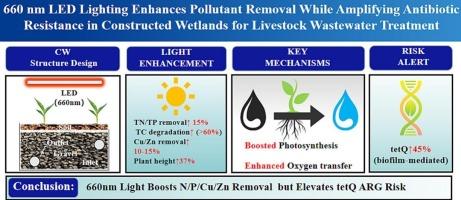Dual effects of 660 nm LED lighting on pollutant removal and antibiotic resistance dynamics in constructed wetlands treating livestock wastewater
IF 6.7
2区 工程技术
Q1 ENGINEERING, CHEMICAL
引用次数: 0
Abstract
Livestock wastewater in developing regions is a major contributor to water quality degradation due to its high content of nitrogen, phosphorus, antibiotics, and heavy metals. Constructed wetlands (CWs) represent cost-effective and environmentally sustainable treatment systems, where plant–microbe interactions facilitate the simultaneous removal of multiple pollutants. However, the operational stability of CWs remains a critical challenge. Within these systems, plants play a central role, with light serving as a key determinant of their physiological and functional dynamics, thereby exerting significant influence on overall CW performance. This laboratory-scale investigation demonstrates that supplementation with 660 nm light-emitting diodes (LEDs) in vertical subsurface flow CWs synergistically enhances both pollutant removal efficiency and operational stability. Illuminated systems exhibited superior nitrogen and phosphorus removal as well as increased tetracycline degradation relative to non-illuminated controls. Photostimulation promoted enhanced growth of Canna indica, with greater plant height (61.8 cm vs. 45.2 cm) and stem diameter (4.35 cm vs. 3.34 cm), accompanied by 2.8–60.7 % higher enzymatic activity. Concurrently, microbial community restructuring enriched functional taxa such as Pseudomonas (8.65 %) and Nitrospira (2.48 %), fostering self-optimizing microbial consortia. Moreover, light supplementation mitigated the abundance of several antibiotic resistance genes (ARGs), specifically tetM, tetO, and tetW, thereby lowering the associated ecological risks. Paradoxically, an increase in tetQ abundance was observed, likely attributable to biofilm-facilitated plasmid transfer. Collectively, these findings highlight light supplementation as a promising strategy to improve CW treatment performance and simultaneously reduce the potential dissemination of resistance genes.

660 nm LED照明对处理畜禽废水人工湿地污染物去除和抗生素耐药性动态的双重影响
发展中地区的畜牧废水由于氮、磷、抗生素和重金属含量高,是水质退化的主要原因。人工湿地(CWs)是具有成本效益和环境可持续性的处理系统,其中植物-微生物相互作用促进同时去除多种污染物。然而,化武的运行稳定性仍然是一个严峻的挑战。在这些系统中,植物发挥着核心作用,光作为其生理和功能动态的关键决定因素,从而对整体连续化学性能产生重大影响。这项实验室规模的研究表明,在垂直潜流CWs中添加660 nm发光二极管(led)可以协同提高污染物去除效率和运行稳定性。照明系统表现出优越的氮和磷去除,以及四环素降解增加相对于未照明的控制。光刺激促进了美人蕉的生长,使其株高(61.8 cm vs. 45.2 cm)和茎粗(4.35 cm vs. 3.34 cm)增加,酶活性提高2.8 ~ 60.7%。同时,微生物群落的重组丰富了假单胞菌(8.65%)和硝化螺旋菌(2.48%)等功能类群,形成了自我优化的微生物群落。此外,光照补充降低了几种抗生素耐药基因(ARGs)的丰度,特别是tetM、tetO和tetW,从而降低了相关的生态风险。矛盾的是,tetQ丰度的增加被观察到,可能归因于生物膜促进质粒转移。总的来说,这些发现突出了补光作为一种有希望的策略,可以提高CW处理性能,同时减少耐药基因的潜在传播。
本文章由计算机程序翻译,如有差异,请以英文原文为准。
求助全文
约1分钟内获得全文
求助全文
来源期刊

Journal of water process engineering
Biochemistry, Genetics and Molecular Biology-Biotechnology
CiteScore
10.70
自引率
8.60%
发文量
846
审稿时长
24 days
期刊介绍:
The Journal of Water Process Engineering aims to publish refereed, high-quality research papers with significant novelty and impact in all areas of the engineering of water and wastewater processing . Papers on advanced and novel treatment processes and technologies are particularly welcome. The Journal considers papers in areas such as nanotechnology and biotechnology applications in water, novel oxidation and separation processes, membrane processes (except those for desalination) , catalytic processes for the removal of water contaminants, sustainable processes, water reuse and recycling, water use and wastewater minimization, integrated/hybrid technology, process modeling of water treatment and novel treatment processes. Submissions on the subject of adsorbents, including standard measurements of adsorption kinetics and equilibrium will only be considered if there is a genuine case for novelty and contribution, for example highly novel, sustainable adsorbents and their use: papers on activated carbon-type materials derived from natural matter, or surfactant-modified clays and related minerals, would not fulfil this criterion. The Journal particularly welcomes contributions involving environmentally, economically and socially sustainable technology for water treatment, including those which are energy-efficient, with minimal or no chemical consumption, and capable of water recycling and reuse that minimizes the direct disposal of wastewater to the aquatic environment. Papers that describe novel ideas for solving issues related to water quality and availability are also welcome, as are those that show the transfer of techniques from other disciplines. The Journal will consider papers dealing with processes for various water matrices including drinking water (except desalination), domestic, urban and industrial wastewaters, in addition to their residues. It is expected that the journal will be of particular relevance to chemical and process engineers working in the field. The Journal welcomes Full Text papers, Short Communications, State-of-the-Art Reviews and Letters to Editors and Case Studies
 求助内容:
求助内容: 应助结果提醒方式:
应助结果提醒方式:


